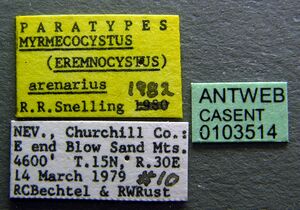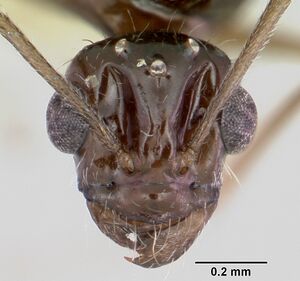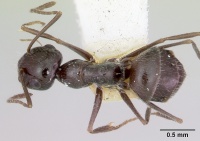Myrmecocystus arenarius
| Myrmecocystus arenarius | |
|---|---|

| |
| Scientific classification | |
| Kingdom: | Animalia |
| Phylum: | Arthropoda |
| Class: | Insecta |
| Order: | Hymenoptera |
| Family: | Formicidae |
| Subfamily: | Formicinae |
| Tribe: | Lasiini |
| Genus: | Myrmecocystus |
| Subgenus: | Eremnocystus |
| Species: | M. arenarius |
| Binomial name | |
| Myrmecocystus arenarius Snelling, R.R., 1982 | |
| Synonyms | |
| |
Only known to nest in areas with fine drifting sands.
| At a Glance | • Replete Workers |
Identification
A member of the subgenus Eremnocystus.
Key to Myrmecocystus subgenus Eremnocystus species.
Worker.—Scape, malar area and propodeum with abundant erect hairs; erect pronotal hairs abundant; pubescence of second tergum sparse to scattered. Female and Male.—Forewing without erect hairs on membrane. (Snelling 1982)
Keys including this Species
Distribution
Only known from Nevada.
Latitudinal Distribution Pattern
Latitudinal Range: 39.61667° to 39.61667°.
| North Temperate |
North Subtropical |
Tropical | South Subtropical |
South Temperate |
- Source: AntMaps
Distribution based on Regional Taxon Lists
Nearctic Region: United States (type locality).
Distribution based on AntMaps
Distribution based on AntWeb specimens
Check data from AntWeb
Countries Occupied
| Number of countries occupied by this species based on AntWiki Regional Taxon Lists. In general, fewer countries occupied indicates a narrower range, while more countries indicates a more widespread species. |

|
Estimated Abundance
| Relative abundance based on number of AntMaps records per species (this species within the purple bar). Fewer records (to the left) indicates a less abundant/encountered species while more records (to the right) indicates more abundant/encountered species. |

|
Biology
Snelling (1982) - The Wheelers and I were able to study this species briefly one day at a station six miles north of Nixon. This is an area of fine, drift-prone sand along the east side of Pyramid Lake. There was a sparse cover of Salsola pestifer and Dalea polyadenia. In one sector the annual, Abronia turbinata, was present and in bloom.
Two nests were situated in unstable sand with sparsely distributed Salsola and scattered Dalea plants. The third was in stabilized sand with denser cover, including Abronia. The only ant species common there was Pogonomyrmex californicus. Veromessor lariversi and Dorymyrmex insanus were also present but uncommon.
Workers of Myrmecocystus arenarius were found foraging up to midmorning. Some were carrying miscellaneous fragments of other arthropods. A number of workers were also seen at nectaries of the Salsola. A single semireplete worker was recovered from one nest, but the unstable condition of the sand rendered deep excavation impractical.
Castes
Worker
Images from AntWeb
   
| |
| Paratype of Myrmecocystus arenarius. Worker. Specimen code casent0103514. Photographer April Nobile, uploaded by California Academy of Sciences. | Owned by USNM, Washington, DC, USA. |
Queen
Images from AntWeb
    
| |
| Paratype of Myrmecocystus arenarius. Queen (alate/dealate). Specimen code casent0103515. Photographer April Nobile, uploaded by California Academy of Sciences. | Owned by USNM, Washington, DC, USA. |
Male
Images from AntWeb
     
| |
| Paratype of Myrmecocystus arenarius. Male (alate). Specimen code casent0105773. Photographer April Nobile, uploaded by California Academy of Sciences. | Owned by USNM, Washington, DC, USA. |
Phylogeny
| Myrmecocystus |
| |||||||||||||||||||||||||||||||||||||||||||||||||||||||||||||||||||||||||||||||||||||||||||||||||||||||||||||||||||||||||||||||||||||||||||||||||||||||||||||||||||||||||||||||||||||||||||||||||||||||||||||||||||||||||||||||||||||||||||||||||||||||||||||||||||||
Based on van Elst et al. (2021).
Nomenclature
The following information is derived from Barry Bolton's Online Catalogue of the Ants of the World.
- arenarius. Myrmecocystus (Eremnocystus) arenarius Snelling, R.R. 1982b: 71, figs. 1-6, 13, 15, 19, 21, 23 (w.q.m.) U.S.A.
- Senior synonym of snellingi Bolton, 1995b: 275 (unnecessary replacement name).
Unless otherwise noted the text for the remainder of this section is reported from the publication that includes the original description.
The preeminent characteristic of this species is the great reduction of the appressed pubescence in all castes. In workers pubescence is abundant only on the dorsal surface of the first gastric tergum. Moderately dense pubescence is present only on the metapleuron, the base of the propodeum and, to a lesser degree, on the propodeal sides of the females and males.
Another unusual feature of this ant is shared by the sexual forms and is, as far as known, unique within this subgenus. Typically, within Eremnocystus (see Myrmecocystus subgenera), the membranes of the wings are beset with numerous fine, very short, subdecumbent to erect white hairs. These hairs are readily discernable at a magnification of 45X. In other subgenera the membrane is dotted with what appear to be, at 45X, minute papillae. In fact, they are hairs, but this becomes apparent only at high magnifications (see figure 33 of my 1976 revision). The wing membrane of Myrmecocystus arenarius is as it is in these other subgenera and thus atypical for a species of Eremnocystus.
While it might, perhaps, be argued that this represents a breakdown of an important characteristic separating Eremnocystus from Endiodioctes in particular, I do riot think this is the case. The presence of hairs on the wing membrane seems to be a primitive feature retained within Eremnocystus generally, but modified in Endiodioctes. In other characteristics Endiodioctes is clearly the least advanced of the several subgenera of Myrmecocystus.
Within Eremnocystus, arenarius is a species with a number of derived character states. Chief among these are the great reduction of appressed pubescence, the fine and very scattered punctation (especially in the sexual forms) and the compressed petiolar scale of the worker. The isolation of this species from others within Eremnocystus is also an important factor. Only M. hammettensis is even geographically near arenarius and that is one of the most pilose of the Eremnocystus. It is highly improbable that there has been any genetic interchange between the two.
Females of arenarius are most similar to those of Myrmecocystus tenuinodis, another species in which the worker petiolar scale is compressed. This species, like arenarius, exhibits a preference for nest sites in fine sand which is prone to drifting. A third species whose worker possesses a compressed petiolar scale is Myrmecocystus lugubris, the female of which is unknown. If the female of lugubris' is found to be sufficiently like those of arenarius and tenuinodis, and I predict that this will be so, we will have a complex of three species aligned along a roughly north-south axis with M. lugubris occupying the middle portion.
As I envision this particular complex, the proto species once occupied a continuous range from what is now western and central Nevada to the head of the Gulf of Mexico and partway down either side of the Gulf. This proto species may have been not very different from the present Myrmecocystus yuma, a species not particularly similar to those of the lugubris complex but nearer them than any others. During the Tertiary the three desert regions became sharply differentiated from one another; the Great Basin became higher and cooler, the Mojave and Sonoran lower and hot. Protospecies populations became isolated from one another and each developed along its own peculiar line in the absence of genetic moderation from other populations.
Description
Worker
Measurements: HL 0.65-1.02 (0.95); HW 0.58-0.90 (0.89); SL 0.66-1.07 (0.96); WL 0.83-1.40 (1.22); PW 0.42-0.63 (0.59).
Head: Longer than broad in all sizes, CI 105-119 (105); in full face view, malar margins nearly straight and convergent toward mandibles in smallest specimens, slightly convex in largest; occiput nearly flat in smallest workers, weakly convex in largest, sides broadly rounded; as long as, to a little shorter than, scape, SI 100-110 (101). Eye small to moderately large, EL 1.00-1.40 (1.31) X first flagellomere; OMD 1.17-1.54 (1.29) X EL. Mandible with seven teeth.
Thorax: Moderately robust, PW 0.43-0.52 (0.48) X WL. Mesonotum, in profile, nearly straight in smallest workers, broadly rounded into a sloping posterior face in largest specimens. Basal face of propodeum, in profile, short and broadly rounded into posterior face in small specimens, distinct, long, and abruptly rounded into posterior face in largest specimens.
Petiole: In profile, compressed and narrowly cuneate; spiracles distinctly projecting in larger specimens; crest broadly concave, in posterior view, in large specimens, flat or weakly notched in small individuals.
Vestiture: Pubescence scattered on head; long and dense, but not concealing surface, on thorax and first gastric tergum. Second tergum with scattered pubescence, usually more conspicuous (especially in larger individuals) along base, midline and at sides of disc. Erect hairs numerous on head; malar area with 5- 11 suberect hairs; scape with sparse erect hairs and numerous shorter, decumbent to subdecumbent hairs; all surfaces of femora and tibiae with numerous erect and suberect hairs. Promesonotum with numerous erect hairs, the longest more than 0.5 X MOD; metanotum usually without erect hairs; dorsum of propodeum with 6 or more fine, short erect hairs. Petiolar scale with erect hairs on sides and crest. Terga with numerous discal hairs, becoming a little longer on succeeding segments.
Integument: Clypeus shiny, with scattered fine and coarse piligerous punctures; remainder of head subpolished, very weakly shagreened, with scattered piligerous punctures, frontal lobes virtually impunctate. Thoracic dorsum shiny, lightly shagreened. Gaster shiny, feebly shagreened.
Color: Medium to dark brown, appendages a little lighter; mandibles and apical part of clypeus yellowish brown, mandibular teeth dark red.
Queen
Measurements (mm): HL 1.36-1.38; HW 1.36-1.41; SL .36-.38; WL 2.51-2.78; PW 1.71-1.87.
Head: As broad as, or a little broader than, long, CI 95-100; in full face view, malar margin nearly straight or very weakly convex; distinctly longer than scape, SI 85-95. Eye small, EL 1.00-1.20 X first flagellomere; OMD 1.00-1.25 X EL. Mandible with seven teeth. Lateral ocelli slightly smaller than anterior ocellus, IOD 2.62-3.28 X OD; OOD 3.50-4.14. X OD. Fifth segment of maxillary palp broad at base, broadest near middle, distinctly narrowed distad; fourth segment narrowest at base, gradually broadened distad.
Thorax: Robust, PW 0.62-0.73 X WL. Posterior half of mesoscutum flattened; scutellum sloping and flat or very gently convex in profile. Basal portion of propodeum, in profile, sloping and abruptly rounded onto declivous face.
Petiole: Strongly compressed in profile, summit thin; in frontal view, sides a little convergent above; median emargination broad, deep, angulate; from above about 3 X wider than long.
Vestiture: Pubescence appressed, very scattered on head, most abundant (but still sparse) on lower malar area; appressed to subdecumbent on mesoscutum, scattered; longer, sparse, prostrate to suberect on sides of thorax, densest on pronotum and propodeum; appressed and scattered on tergal discs, becoming a little more abundant toward sides and apical margins.
Scape with pubescence subdecumbent to suberect and with scattered fine, suberect hairs; femora and tibiae with abundant appressed to subdecumbent pubescence and numerous subdecumbent to erect hairs on all surfaces, least abundant on dorsal (extensor) femoral surfaces. Malar area, in frontal view, with 6-10 subdecumbent hairs; remaining frontal and dorsal head surface with rather sparse, short subdecumbent to erect hairs, longest hairs on occiput more than 0.5 X MOD. Scutum with sparse suberect to erect hairs, mainly peripherally, longest no more than 0.5 X MOD; scutellum with scattered suberect to erect hairs, longest more than MOD; pleura with scattered suberect to erect hairs, longest about 0.5 X MOD; propodeum with sparse erect hairs across base and at sides of declivity. Petiolar scale with a few short, erect hairs on sides and across summit. All terga with sparse, suberect to erect hairs, becoming longer and coarser caudad, longest on disc of second segment no more than 0.5 X MOD.
Membrane of forewing without obvious erect hairs at 45X; forewing without fringe hairs and hindwing with a very few on basal half of posterior margin.
Integument: Shiny and very weakly, or not at all, shagreened on most areas, including gastric terga; metapleuron and propodeum conspicuously duller.
Head generally with scattered minute punctures; clypeus with a few fine punctures. Mesoscutum with scattered fine punctures, middle of disc nearly impunctate; minute punctures even more scattered. Scutellum with sparse, fine setigerous punctures. Anepisternum for the most part with sparse to scattered fine and minute punctures; katepisternum similar but with posterior and posterodorsal zones of dense punctures; metapleuron and propodeum densely and finely punctate. Tergal discs with sparse to scattered minute to ultraminute punctures.
Color: Medium brown, sides and propodeum darker; appendages light brown. Wings hyaline, veins and stigma yellowish brown.
Male
Measurements (mm): HL 0.60-0.64 (0.64); HW 0.54-0.60 (0.60); SL 0.58-0.64 (0.64); WL 1.15-1.33 (1.33); PW 0.76-0.88 (0.76).
Head: Slightly to distinctly longer than broad, CI 104-117 (106), as long as, or longer than, scape, SI 94-100. In frontal view, margins distinctly convergent toward mandibular bases; occiput broadly convex, lateral angles broadly rounded. Eye large, OMD 0.47-0.65 (0.53) X EL; lateral ocelli slightly larger than anterior, IOD 3.20-4.00 (3.75) X OD; OOD 2.75-3.25 (3.25) X OD. Mandible with distinct preapical cleft and one or two small teeth on cutting margin.
Thorax: Stout, PW 0.57-0.70 (0.57) X WL. Mesoscutum broad, vertical in front, posterior half fiat or weakly concave; scutellum, in profile, with fiat dorsal surface and abruptly sloping posterior face. Basal face of propodeum, in profile, narrow, convex and abruptly rounded into posterior face.
Petiole: Cuneate in profile, posterior face weakly convex, summit narrowly rounded; posterior view, crest straight or broadly and very shallowly concave.
Pilosity: Pubescence very fine, short, very scattered, most conspicuous on metapleuron and side of propodeum.
Scape with numerous very fine and short subdecumbent to suberect hairs; femora and tibiae with longer, coarser, sparse suberect hairs on all surfaces. Head and thorax with sparse to scattered subdecumbent to erect hairs, longest occipital hairs about 0.5 X MOD. Gastric terga with sparse, subdecumbent to erect hairs, longest on disc of second segment no more than 0.5 X MOD. Wings as in female. Integument: Shiny and, at most, very weakly shagreened on most surfaces of head, thorax and gaster; metapleuron and basal face of propodeum moderately shiny, closely, though weakly, punctulate.
Color: Medium brown, occiput and thoracic dorsum a little darker, gaster a little paler. Appendages light brown. Wings hyaline, veins and stigma very pale brownish.
Type Material
Holotype worker, allotype and 211 worker, 8 female, 10 male paratypes: E end Blow Sand Mts., elev. 4600', (T 15N, R 30E), Churchill Co., NEVADA, 14 Mar. 1979 (R. C. Bechtel and R. W. Rust). Additional paratypes: 173 workers, 4 females, 11 males, same locality, 4 Apr. 1979 (R. C. Bechtel and R. L. Bradley). Holotype, allotype and most paratypes in Los Angeles County Museum of Natural History; paratypes in American Museum of Natural History, Museum of Comparative Zoology, National Museum of Natural History and collection of G. C. & J. Wheeler.
References
- Bolton, B. 1995b. A new general catalogue of the ants of the world. Cambridge, Mass.: Harvard University Press, 504 pp. (page 275, new name)
- Cantone S. 2018. Winged Ants, The queen. Dichotomous key to genera of winged female ants in the World. The Wings of Ants: morphological and systematic relationships (self-published).
- Finzi, B. 1940 [1939]. Formiche della Libia. Memorie della Societa Entomologica Italiana 18: 155-166 (page 164, Junior primary homonym of arenaria)
- Plowes, N.J.R., Johnson, R.A., Holldobler, B. 2013. Foraging behavior in the ant genus Messor (Hymenoptera: Formicidae: Myrmicinae). Myrmecological News 18, 33-49.
- Snelling, R. R. 1982b. A revision of the honey ants, genus Myrmecocystus, first supplement (Hymenoptera: Formicidae). Bull. South. Calif. Acad. Sci. 81: 69-86 (page 71, arenarius)
References based on Global Ant Biodiversity Informatics
- Snelling R. R. 1982. A revision of the honey ants, genus Myrmecocystus, first supplement (Hymenoptera: Formicidae). Bulletin of the Southern California Academy of Sciences 81: 69-86
- Snelling, R.R. 1982. A revision of the honey ants, genus Myrmecocystus, first supplement (Hymenoptera: Formicidae) Bulletin of the Southern California Academy of Sciences 81(2):69-86
- Wheeler G. C., and J. Wheeler. 1986. The ants of Nevada. Los Angeles: Natural History Museum of Los Angeles County, vii + 138 pp.


